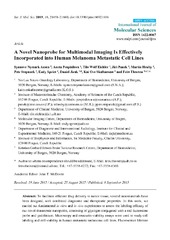| dc.contributor.author | Aasen, Synnøve Nymark | en_US |
| dc.contributor.author | Pospíšilová, Aneta | en_US |
| dc.contributor.author | Eichler, Tilo Wolf | en_US |
| dc.contributor.author | Pánek, Jiří | en_US |
| dc.contributor.author | Hrubý, Martin | en_US |
| dc.contributor.author | Štěpánek, Petr | en_US |
| dc.contributor.author | Spriet, Endy | en_US |
| dc.contributor.author | Jirák, Daniel | en_US |
| dc.contributor.author | Skaftnesmo, Kai Ove | en_US |
| dc.contributor.author | Thorsen, Frits | en_US |
| dc.date.accessioned | 2016-01-11T09:17:37Z | |
| dc.date.available | 2016-01-11T09:17:37Z | |
| dc.date.issued | 2015-09-08 | |
| dc.Published | International Journal of Molecular Sciences 2015, 16(9):21658-21680 | eng |
| dc.identifier.issn | 1422-0067 | |
| dc.identifier.uri | https://hdl.handle.net/1956/10907 | |
| dc.description.abstract | To facilitate efficient drug delivery to tumor tissue, several nanomaterials have been designed, with combined diagnostic and therapeutic properties. In this work, we carried out fundamental in vitro and in vivo experiments to assess the labeling efficacy of our novel theranostic nanoprobe, consisting of glycogen conjugated with a red fluorescent probe and gadolinium. Microscopy and resazurin viability assays were used to study cell labeling and cell viability in human metastatic melanoma cell lines. Fluorescence lifetime correlation spectroscopy (FLCS) was done to investigate nanoprobe stability. Magnetic resonance imaging (MRI) was performed to study T1 relaxivity in vitro, and contrast enhancement in a subcutaneous in vivo tumor model. Efficient cell labeling was demonstrated, while cell viability, cell migration, and cell growth was not affected. FLCS showed that the nanoprobe did not degrade in blood plasma. MRI demonstrated that down to 750 cells/μL of labeled cells in agar phantoms could be detected. In vivo MRI showed that contrast enhancement in tumors was comparable between Omniscan contrast agent and the nanoprobe. In conclusion, we demonstrate for the first time that a non-toxic glycogen-based nanoprobe may effectively visualize tumor cells and tissue, and, in future experiments, we will investigate its therapeutic potential by conjugating therapeutic compounds to the nanoprobe. | en_US |
| dc.language.iso | eng | eng |
| dc.publisher | MDPI | eng |
| dc.rights | Attribution CC BY | eng |
| dc.rights.uri | http://creativecommons.org/licenses/by/4.0/ | eng |
| dc.subject | melanoma brain metastasis | eng |
| dc.subject | nanoprobe | eng |
| dc.subject | theranostics | eng |
| dc.subject | Magnetic resonance imaging | eng |
| dc.subject | fluorescence microscopy | eng |
| dc.subject | high throughput microscopy | eng |
| dc.subject | fluorescence lifetime correlation spectroscopy | eng |
| dc.subject | zeta potential | eng |
| dc.title | A novel nanoprobe for multimodal imaging is effectively incorporated into human melanoma metastatic cell lines | en_US |
| dc.type | Peer reviewed | |
| dc.type | Journal article | |
| dc.date.updated | 2015-12-22T10:36:34Z | |
| dc.description.version | publishedVersion | en_US |
| dc.rights.holder | Copyright 2015 The Authors | |
| dc.identifier.doi | https://doi.org/10.3390/ijms160921658 | |
| dc.identifier.cristin | 1282250 | |

